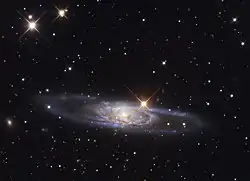| NGC 5792 | |
|---|---|
 NGC 5792 (32 inch Schulman Telescope) | |
| Observation data (J2000 epoch) | |
| Constellation | Libra |
| Right ascension | 14h 58m 22.7s[1] |
| Declination | −01° 07′ 28″ |
| Redshift | 0.006411[1] |
| Heliocentric radial velocity | 1922 ± 4 km/s[1] |
| Distance | 70.27 ± 18.54 Mly (21.545 ± 5.685 Mpc)[1] |
| Apparent magnitude (V) | 12.1[1] |
| Characteristics | |
| Type | SB(rs)b[1] |
| Apparent size (V) | 6.9′ × 1.7′[1] |
| Other designations | |
| UGC 9631, MCG +00-38-012, PGC 53499[1] | |
NGC 5792 is a barred spiral galaxy about 70 million light-years[1] away in the constellation Libra. There is a magnitude 9.6 star on the northwestern edge of the galaxy.[2] It was discovered on April 11, 1787, by the astronomer William Herschel.[3] It is a member of the Virgo III Groups, a series of galaxies and galaxy clusters strung out to the east of the Virgo Supercluster of galaxies.[4]
 GALEX (ultraviolet)
GALEX (ultraviolet) The Core of NGC 5792, Hubble Space Telescope
The Core of NGC 5792, Hubble Space Telescope
.jpg.webp) NGC 5792 (SDSS)
NGC 5792 (SDSS)
References
- 1 2 3 4 5 6 7 8 9 "Results for NGC 5792". NASA/IPAC Extragalactic Database. Retrieved 2010-05-19.
- ↑ Bakich, Michael (2010). 1,001 Celestial Wonders to See Before You Die: The Best Sky Objects for Star Gazers. Springer. p. 173. ISBN 978-1441917768.
- ↑ Seligman, Courtney. "New General Catalogue objects: NGC 5750 - 5799". cseligman.com. Retrieved 2021-02-24.
- ↑ "The Virgo III Groups". Atlas of the Universe. Retrieved 2010-11-27.
External links
Wikimedia Commons has media related to NGC 5792.
- NGC 5792 on WikiSky: DSS2, SDSS, GALEX, IRAS, Hydrogen α, X-Ray, Astrophoto, Sky Map, Articles and images
This article is issued from Wikipedia. The text is licensed under Creative Commons - Attribution - Sharealike. Additional terms may apply for the media files.